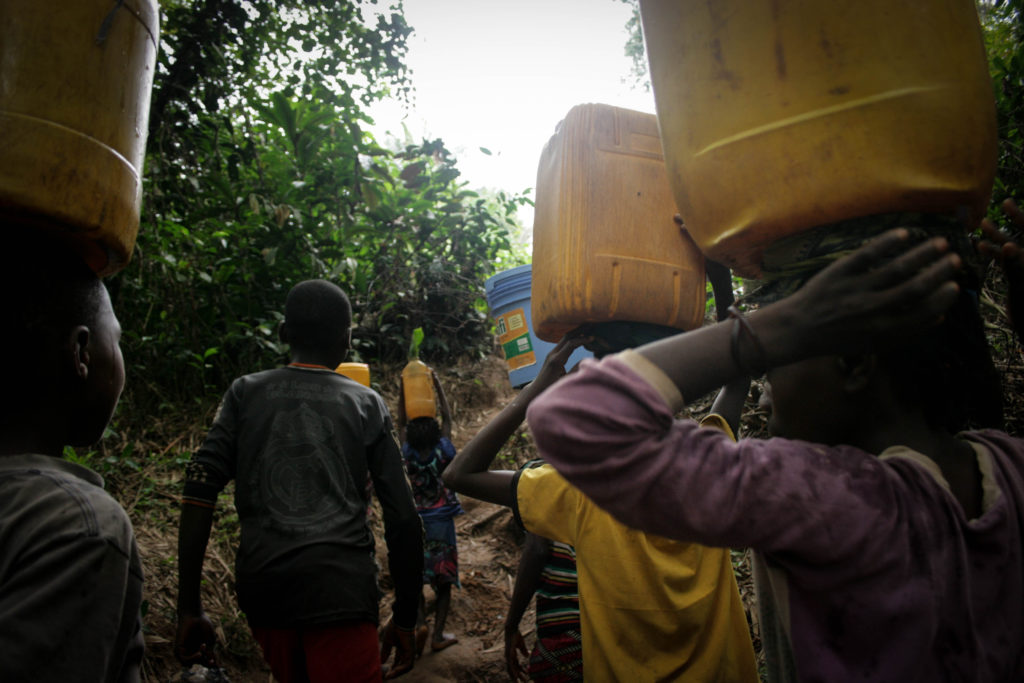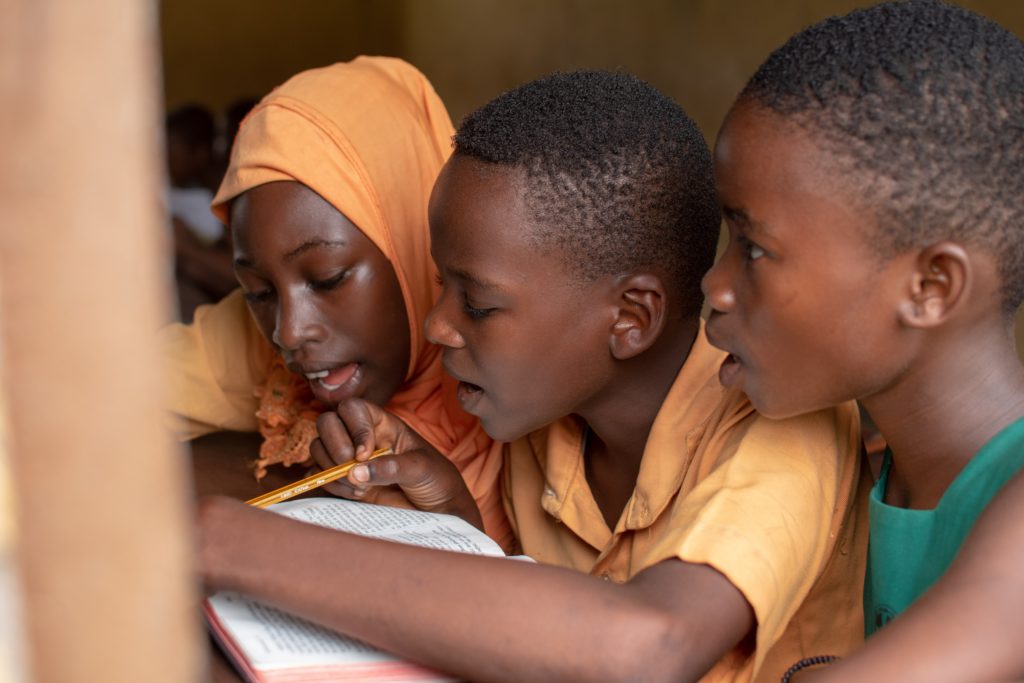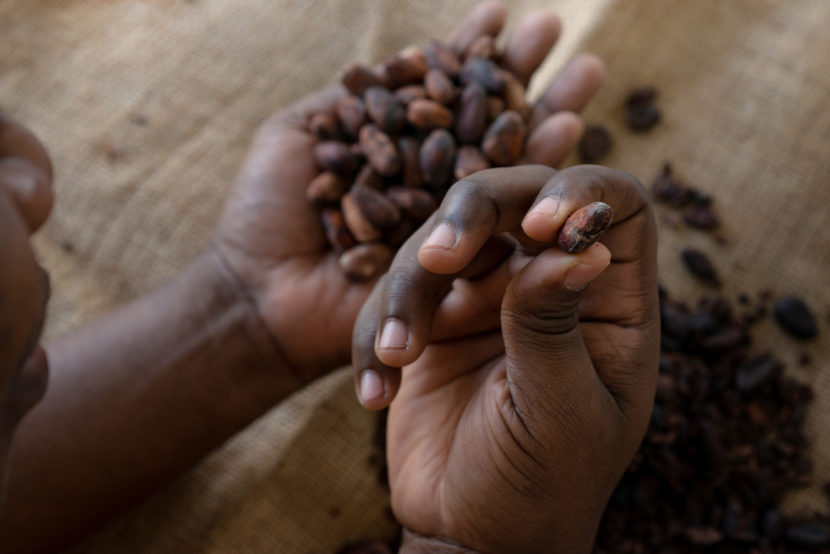When the world thinks of chocolate, they frequently think of Europe – of countries like Switzerland, Belgium or the Netherlands – all of which are well known for the high-quality chocolate they produce. The reality, however, is that 70% of the world’s cocoa beans originate in Ivory Coast and Ghana, and over 2 million West African children work to produce it, most of the time, in hazardous conditions.
How many children are involved in cocoa production?
Chocolate is a product of the cacao bean, which grows primarily in the tropical climates of Western Africa, Asia, and Latin America. The cacao bean is more commonly referred to as cocoa. Western African countries, mostly Ghana and the Ivory Coast, supply about 70% of the world’s cocoa (Food Empowerment Project, 2022).
Approximately 2.1 million children in the Ivory Coast and Ghana work on cocoa farms, most of whom are likely exposed to the worst forms of child labour (Food Empowerment Project, 2022). Moreover, migrant children from Mali and Burkina Faso also come to Ivory Coast and Ghana to work in cocoa fields.
Most of the children labouring on cocoa farms are between the ages of 12 and 16, but reporters have found children as young as 5. In addition, 40% of these children are girls, and some end up working on cocoa farms through adulthood (Food Empowerment Project, 2022).
Even though child labour is illegal in Ghana and Ivory Coast, it is still the main source of cocoa production. Children are forced to lie about their age. In an investigation by The Washington Post, a cocoa labourer named Abou Traore first told a reporter that he was 19 years old, but when the farmer overseeing him wasn’t looking, Abou revealed that he was actually 15 (Food Empowerment Project, 2022).
The economics of cocoa
The cocoa value chain is complex. Approximately five to six million smallholder farms under five hectares in size produce 90% of the global cocoa supply. Two countries, Ghana and Ivory Coast, account for around 60% of global cocoa production. Farmers sell cocoa beans to aggregators, who gather them in volume from multiple regions to sell to traders and exchanges before they are acquired by processors. Ground beans are then sold to manufacturers, brands, and retailers, who face the challenge of tracing the commodity back to its plantation of origin (Krisanda, Rojas, 2024).
Downward pressure on prices and fluctuating demand leaves cocoa farmers vulnerable to an unstable income. During the 1970s, cocoa farmers received 50% of the value of a chocolate bar. Today, however, that value has fallen to just 6%. Meanwhile, throughout 2023, chocolate prices rose by 14%.
Nevertheless, an average cocoa farmer in Ghana and Ivory Coast earns 40% of a living income, which is the local minimum income needed to cover a household’s basic needs (Krisanda, Rojas, 2024). Most cocoa farmers earn less than $1 per day, an income below the extreme poverty line. As a result, they often resort to the use of child labour to keep their prices competitive (Food Empowerment Project, 2022).
Other labourers come from the steady stream of child migrants who are brought to the Ivory Coast by people other than their parents. At least 16,000 children, and perhaps many more, are forced to work on West African cocoa farms by people other than their parents, according to estimates from a 2018 survey. The child migrants arrive amid a vast wave of people entering from Burkina Faso and Mali. Ivory Coast is home to 1.3 million migrants from Burkina Faso and another 360,000 from Mali, according to the United Nations. Mali, Burkina Faso and Ivory Coast share an agreement on open borders (Whoriskey, Siegel, 2019).
“There is no money in Burkina. … We came here to be able to have some money to eat.”
– Karim Bakary, 16 years old, child labourer (Whoriskey, Siegel, 2019)
Child trafficking
The children of Western Africa are surrounded by intense poverty, and many begin working at a young age to help support their families. Some children end up on the cocoa farms because they need work and traffickers tell them that the job pays well (Food Empowerment Project, 2022). Traffickers typically offer the children, who could be as young as 10, money or more specific incentives, such as bicycles, to take the bus to Ivory Coast (Whoriskey, Siegel, 2019).
Other children are sold to traffickers or farm owners by their relatives, who are unaware of the dangerous work environment and the lack of any provisions for an education (Food Empowerment Project, 2022). Often, traffickers abduct young children from small villages in neighbouring African countries, such as Burkina Faso and Mali, two of the poorest countries in the world. Traffickers will then sell children to cocoa farmers (Food Empowerment Project, 2022).
Once they have been taken to the cocoa farms, the children may not see their families for years, if ever. If a child who has been trafficked wants to go home, they will likely not be allowed because the trafficker has sold them to work on the cocoa farms for a certain number of years. Journalists who went undercover as cocoa farmers documented traffickers in Ghana selling children to them for $34 a child (Food Empowerment Project, 2022).
Risks related to the working conditions in the cocoa fields

Child labour is defined by the International Labour Organization (ILO) as “work that deprives children of their childhood, their potential and their dignity, and that is harmful to their physical and mental development” (ILO, n.d.). Not all work done by children is classified as child labour. For instance, children carrying out light, non-hazardous tasks on the family farm for a limited period, under adult supervision, and without compromising their schooling, is considered acceptable child work (Cocoa Initiative, n.d.).
This type of work is often necessary for the welfare of many families and it also contributes to children’s development, providing them with skills and experience that help them prepare for adult life. However, when activities are hazardous, it is considered child labour and is not allowed (Cocoa Initiative, n.d.).
Children working in cocoa production may face different risks (Food Empowerment Project, 2022):
- Long working hours – Child labourers on cocoa farms work long hours, with some being forced to work up to 14 hours a day.
- Dangerous tools – Some of the children use chainsaws to clear the forests. Other children climb the cocoa trees to cut bean pods using a machete.
- Heavy lifting – Once they cut the bean pods from the trees, the children pack the pods into sacks that weigh more than 100 pounds when full and carry them through the forest.
- Exposure to agricultural chemicals – Tropical regions such as Ghana and the Ivory Coast consistently choose to deal with prolific insect populations by spraying the pods with large amounts of industrial chemicals. Young children spray the pods with these toxins without wearing protective clothing. There has been a huge increase in the past decade in the number of children exposed to agricultural chemicals on Ghana and the Ivory Coast’s cocoa farms, from 15% of children to approximately 50% of children.
- Lack of access to nutritious and diverse food – Farm owners who use child labour usually provide children with the cheapest food available, such as corn paste or cassava and bananas that grow in the surrounding forest.
- Lack of access to water and sanitation – In some cases, the children sleep on wooden planks in small windowless buildings with no access to clean water or sanitary bathrooms.
- Lack of access to education – Around 30% of children labouring on cocoa farms in the Ivory Coast do not attend school, which violates the ILO’s Child Labour Standards. Parents are forced to include their children in farm labour instead of sending them to school because they are not paid enough for the cocoa they sell.
Efforts to regulate the chocolate industry
The Harkin Engel Protocol
In 2001, chocolate and cocoa industry representatives (Hershey, Mars, Nestlé USA and five other chocolate companies) and the Ambassador of Ivory Coast signed an agreement, known as the “Harkin Engel Protocol” as it was developed in partnership with US Senator Tom Harkin and US Representative Eliot Engel (Cocoa Initiative, n.d.). The Protocol aimed to eliminate the worst forms of child labour in producing and processing cocoa beans and their derivative products wherever cocoa is grown (Whoriskey, Siegel, 2019).
The Cocoa Protocol was signed in response to numerous reports and documentaries about child slavery in the cocoa industry (The World Counts, n.d.). The chocolate companies signed the Harkin-Engel Protocol because they were desperate to avoid proposed legislation that would have created a federal certification system to indicate whether or not cocoa was harvested using child slavery. Instead, under the protocol, the responsibility to end child labour and slavery in the chocolate industry was placed on the chocolate companies (Food Empowerment Project, 2022).
In 2007, the industry sought to reconstrue the meaning of a key clause in the agreement. Industry officials argued that the promised “standards of public certification” did not mean, as some negotiators had thought, the creation of consumer labels indicating that a chocolate bar was free of child labour. Instead, the industry said, the agreement meant that the companies would produce statistics on West African “labour conditions” and “the levels” of child labour in West Africa (Whoriskey, Siegel, 2019).
After missing the 2010 deadline, the industry established a less ambitious goal — to get a 70% reduction in child labour — and to do so by 2020. That goal, too, is unlikely to be met, the industry has indicated, and there is still no plan for consumer labels (Whoriskey, Siegel, 2019).
The cocoa industry’s initiatives
For years, the chocolate industry has not sufficiently addressed accusations of child labour in its supply chain, and many companies refuse to release information about where they sourced their cocoa. Recently, many of the world’s largest chocolate manufacturers have admitted to the existence of child labour and slavery within their supply chains, but this is only because they have been pressured by consumers (Food Empowerment Project, 2022).
The world’s largest chocolate manufacturers have formed various initiatives to supposedly address child labour and slavery in cocoa production, but these initiatives have unsurprisingly done little to remove either abuse and they often don’t even involve very many farmers. Nestle’s Cocoa Plan, for instance, only works with 5% of cocoa farmers in the Ivory Coast. There has been almost no reporting that reveals any large-scale impact of these programs (Food Empowerment Project, 2022).
Certification labels: Fairtrade, UTZ and Rainforest Alliance
As the industry struggled to come up with its own system for monitoring child labour, it increasingly turned to third parties to tackle the problem. Three nonprofit groups — Fairtrade, Utz and Rainforest Alliance — provide labels to products that have been produced according to their ethical standards, which include a prohibition on child labour. Over the past decade, the chocolate companies have pledged to buy increasing amounts of cocoa certified by one of these three groups. Mars reports buying about half of its cocoa from certified sources; Hershey reports 80% (Whoriskey, Siegel, 2019).
The truth is that as consumers today, we have no sure way of knowing if the chocolate we buy involves the use of slavery or child labour. Between a quarter and a third of all cocoa is grown under a certification label, such as various fair trade certifications and the Rainforest Alliance/UTZ Certification; however, no single label can guarantee that the chocolate was made without the use of exploitive labour.
The third-party inspectors for these certifications are usually only required to visit fewer than 10% of cocoa farms. Moreover, audits are usually announced in advance, which enables farmers to hide evidence of rule violations. These inspections have made child labour more hidden while remaining just as prevalent (Food Empowerment Project, 2022).
What you can do as a consumer
Investigate the company
- Check on the company from which you are buying chocolate. As a consumer, you can dictate where the market goes and which company or brand thrives.
- Look for certifications like Fairtrade, UTZ, or Rainforest Alliance, but also check independent reviews and reports on the company’s practices regarding child labour. Websites like the Food Empowerment Project or ethical consumer guides can provide insights.
- Use tools like the “Good On You” app or Ethical Consumer’s guides to assess a company’s reputation and commitment to ethical practices.
Raise awareness
- Reach out to companies directly via email or social media. Express your concerns about child labour and demand transparency in their supply chain. You can use sample letters available online or craft a personalized message.
- Join or support campaigns and petitions that advocate for child labour-free chocolate. Diverse organizations often have ongoing campaigns, consider joining them!
- Boycott products from companies that do not commit to ethical practices and support those that do. Share your choices and reasons on social media to influence others.
Get involved
- Get involved with organizations that fight against child labour, such as Humanium, by making a donation, sponsoring a child, or becoming a volunteer!
- Use your social media platforms, blogs, or community groups to spread awareness about child labour in the cocoa industry.
- Share articles, documentaries, and information from reliable sources.
- Organize or participate in events, fundraisers, or awareness campaigns to support the cause and gather more community support.

Written by Arianna Braga
References:
Cocoa Initiative (n.d.). Child labour in cocoa. Retrieved from Cocoa Initiative at https://www.cocoainitiative.org/issues/child-labour-cocoa, accessed on 18 July 2024.
Food Empowerment Project (2022). Child Labor and Slavery in the Chocolate Industry. Retrieved from Food Empowerment Project at https://foodispower.org/human-labor-slavery/slavery-chocolate/, accessed on 17 July 2024.
ILO (n.d.). What is child labour. Retrieved from International Labour Organization (ILO) at https://www.ilo.org/topics/child-labour/what-child-labour, accessed on 18 July 2024.
Krisanda S., Rojas H. (2024). Child Labor in Cocoa Supply Chains: Unveiling the Layers of Human Rights Challenges. Retrieved from Sustainalytics at https://www.sustainalytics.com/esg-research/resource/investors-esg-blog/child-labor-in-cocoa-supply-chains–unveiling-the-layers-of-human-rights-challenges, accessed on 17 July 2024.
The Word Counts (n.d.). Retrieved from The World Counts at https://www.theworldcounts.com/stories/child-labor-in-chocolate-industry, accessed on 15 July 2024.
Whoriskey, Siegel (2019). Cocoa’s child laborers. Retrieved from Washington Post at https://www.washingtonpost.com/graphics/2019/business/hershey-nestle-mars-chocolate-child-labor-west-africa/, accessed on 15 July 2024.


